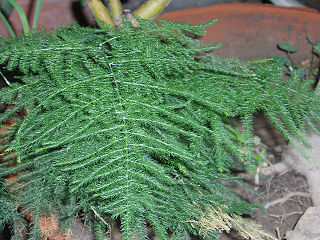
Asparagus is a genus of flowering plants in the family Asparagaceae, subfamily Asparagoideae. It comprises up to 300 species. Most are evergreen long-lived perennial plants growing from the understory as lianas, bushes or climbing plants. The best-known species is the edible Asparagus officinalis, commonly referred to as just asparagus. Some other members of the genus, such as Asparagus densiflorus, are grown as ornamental plants.

Hemerocallidoideae is a subfamily of flowering plants, part of the family Asphodelaceae sensu lato in the monocot order Asparagales according to the APG system of 2016. Earlier classification systems treated the group as a separate family, the Hemerocallidaceae. The name is derived from the generic name of the type genus, Hemerocallis. The largest genera in the group are Dianella, Hemerocallis (15), and Caesia (11).
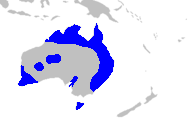
Xanthorrhoea is a genus of about 30 species of succulent flowering plants in the family Asphodelaceae. They are endemic to Australia. Common names for the plants include grasstree, grass gum-tree, kangaroo tail, balga, yakka, yamina (Tasmania), and black boy. The most common species is Xanthorrhoea australis, and some of these names are applied specifically to this species.

Asphodelaceae is a family of flowering plants in the order Asparagales. Such a family has been recognized by most taxonomists, but the circumscription has varied widely. In its current circumscription in the APG IV system, it includes about 40 genera and 900 known species. The type genus is Asphodelus.
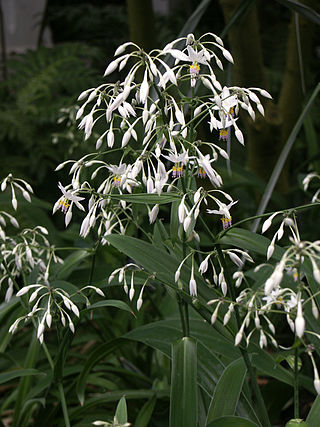
Arthropodium is a genus of herbaceous perennial plants in the subfamily Lomandroideae of the family Asparagaceae. Members of this genus are native to Australia, New Zealand, New Caledonia, and Madagascar.
Botanical nomenclature is the formal, scientific naming of plants. It is related to, but distinct from taxonomy. Plant taxonomy is concerned with grouping and classifying plants; botanical nomenclature then provides names for the results of this process. The starting point for modern botanical nomenclature is Linnaeus' Species Plantarum of 1753. Botanical nomenclature is governed by the International Code of Nomenclature for algae, fungi, and plants (ICN), which replaces the International Code of Botanical Nomenclature (ICBN). Fossil plants are also covered by the code of nomenclature.

Asparagaceae, known as the asparagus family, is a family of flowering plants, placed in the order Asparagales of the monocots. The family name is based on the edible garden asparagus, Asparagus officinalis. This family includes both common garden plants as well as common houseplants. The garden plants include asparagus, yucca, bluebell, and hosta, and the houseplants include snake plant, corn cane, spider plant, and plumosus fern.

Lomandroideae is a subfamily of monocot flowering plants in the family Asparagaceae, order Asparagales, according to the APG III system of 2009. The subfamily name is derived from the generic name of the type genus, Lomandra. The group has previously been treated as a separate family Laxmanniaceae. In the Kubitzki system, it is treated as Lomandraceae Lotsy.

Romnalda is a genus of monocotyledonous plants in the family Asparagaceae, subfamily Lomandroideae. As of December 2013 four formally named species are known and accepted by botanical science.
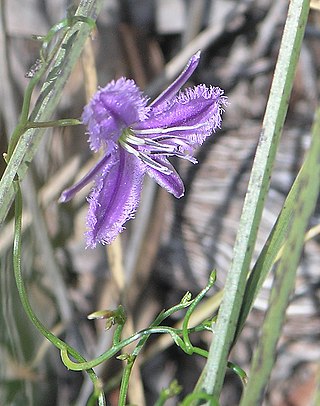
Thysanotus is a genus of perennial herbs in the family Asparagaceae, subfamily Lomandroideae. They are mostly native to Australia with 45 of the 50 known species occurring in Western Australia alone, although a few species range northward into New Guinea and Southeast Asia as far north as southern China.

Acanthocarpus is a genus in the family Asparagaceae, subfamily Lomandroideae, in the APG III system of classification. It has been difficult to place at family rank, being placed at various times in Dasypogonaceae as well as the Asparagaceae. The entire genus is endemic to the State of Western Australia.

Eustrephus is a monotypic genus in the family Asparagaceae, subfamily Lomandroideae. The sole species is Eustrephus latifolius, commonly known as wombat berry. It is an evergreen vine native to Malesia, the Pacific Islands and eastern Australia. It grows in sclerophyll forest, woodland, heathlands, shrublands, gallery forest and rainforests.

Dichopogon is a genus of perennial herbs, native to Australia and New Guinea. It is included in the genus Arthropodium by some authorities, although recognized as a distinct genus by others. In the APG III classification system, it is placed in the family Asparagaceae, subfamily Lomandroideae.
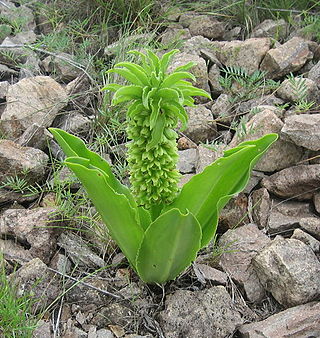
Eucomis is a genus of flowering plants in the family Asparagaceae, subfamily Scilloideae, native to southern Africa. Most species of this genus are commonly referred to as pineapple flowers or pineapple lilies. They are bulbous perennials with basal rosettes of leaves and stout stems covered in star-shaped flowers with a tuft of green bracts at the top, superficially resembling a pineapple – hence the common names.

Laxmannia is a genus of tufted perennial herbs in the family Asparagaceae, subfamily Lomandroideae, that are endemic to Australia.

Xerolirion is a monotypic genus of perennial herbs in the family Asparagaceae, subfamily Lomandroideae. The only known species is Xerolirion divaricata, commonly known as Basil's asparagus, from Western Australia.
The Asparagales are an order of plants, and on this page the structure of the order is used according to the APG III system. The order takes its name from the family Asparagaceae and is placed in the monocots. The order is clearly circumscribed on the basis of DNA sequence analysis, but is difficult to define morphologically, since its members are structurally diverse. The APG III system is used in World Checklist of Selected Plant Families from the Royal Botanical Gardens at Kew. With this circumscription, the order consists of 14 families with approximately 1120 genera and 26000 species.

Lomandra effusa is a perennial, dioecious, rhizomatous herb native to Australia. It is a perennial tussock with bluish green, large, arching leaves which are distinctive by the two toothed leaf tip. It has white, cream or pink fragrant flowers during the months of June to October.

Laxmannia squarrosa is a species of Laxmannia, a genus of tufted perennial herbs in the family Asparagaceae, subfamily Lomandroideae, which is endemic to Western Australia. From 0.03 to 0.1 m high, it grows on gravel and lateritic sand, and its white flowers may be seen from September to November.

The Iron-grass Natural Temperate Grassland of South Australia is a temperate grassland in the southeast of South Australia that stretches from Orroroo in the north, to Strathalbyn in the south, just straddling the eastern fringes of Adelaide's Mount Lofty Ranges. Listed as Critically Endangered under the EPBC Act, the grasslands predominantly feature Iron-grasses.

















